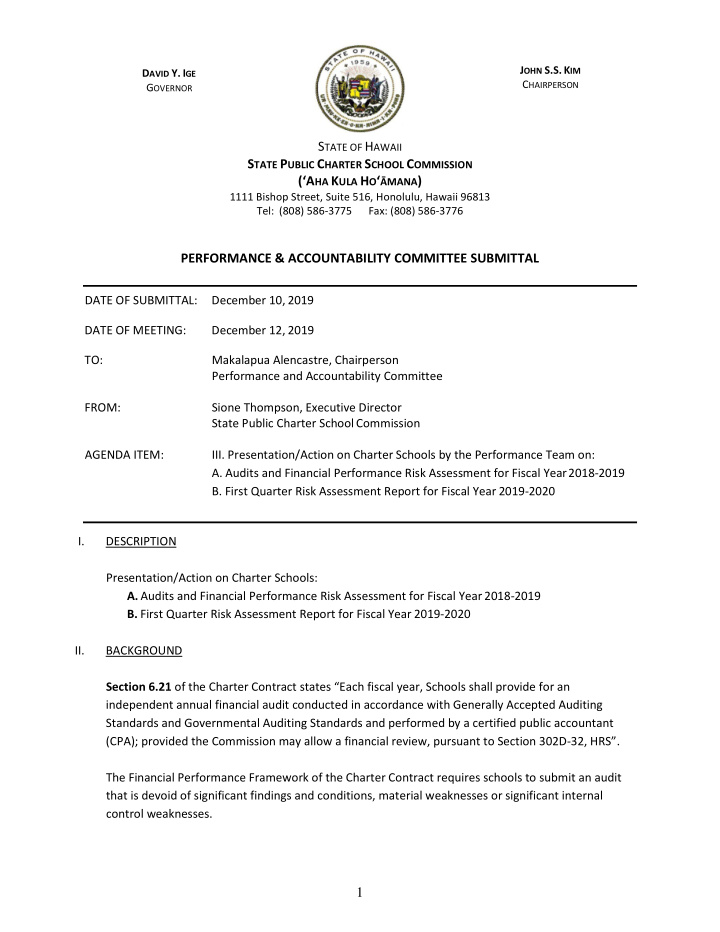



J OHN S.S. K IM D AVID Y. I GE C HAIRPERSON G OVERNOR S TATE OF H AWAII S TATE P UBLIC C HARTER S CHOOL C OMMISSION (ʻA HA K ULA H O ʻ ĀMANA ) 1111 Bishop Street, Suite 516, Honolulu, Hawaii 96813 Tel: (808) 586-3775 Fax: (808) 586-3776 PERFORMANCE & ACCOUNTABILITY COMMITTEE SUBMITTAL DATE OF SUBMITTAL: December 10, 2019 DATE OF MEETING: December 12, 2019 TO: Makalapua Alencastre, Chairperson Performance and Accountability Committee FROM: Sione Thompson, Executive Director State Public Charter School Commission AGENDA ITEM: III. Presentation/Action on Charter Schools by the Performance Team on: A. Audits and Financial Performance Risk Assessment for Fiscal Year 2018-2019 B. First Quarter Risk Assessment Report for Fiscal Year 2019-2020 I. DESCRIPTION Presentation/Action on Charter Schools: A. Audits and Financial Performance Risk Assessment for Fiscal Year 2018-2019 B. First Quarter Risk Assessment Report for Fiscal Year 2019-2020 II. BACKGROUND Section 6.21 of the Charter Contract states “Each fiscal year, Schools shall provide for an independent annual financial audit conducted in accordance with Generally Accepted Auditing Standards and Governmental Auditing Standards and performed by a certified public accountant (CPA); provided the Commission may allow a financial review, pursuant to Section 302D-32, HRS”. The Financial Performance Framework of the Charter Contract requires schools to submit an audit that is devoid of significant findings and conditions, material weaknesses or significant internal control weaknesses. 1
Hawaii Revised Statutes §302D-17 provides that “(a) An authorizer shall continually monitor the performance and legal compliance of the public charter schools it oversees, including collecting and analyzing data to support ongoing evaluation according to the charter contract.” The State Public Charter School Contract requires schools to prepare and submit quarterly financial reports to the Commission, which includes a balance sheet, income statement, and statement of cash flows. The quarterly financial reports are key documents that provide the necessary financial information needed by the Commission to perform periodic financial monitoring of a school, which is a component of its general oversight function. III. PRESENTATION Commission staff has reviewed and analyzed the financial audits submitted by the schools for Fiscal Year 2018-2019. Of the 36 schools operating in Fiscal Year 2018-2019, audit findings were present in ten audits. A total of ten findings were indicated from these ten audits, therefore, no school received multiple audit findings. Of the ten total audit findings for Charter schools in Fiscal Year 2018-2019, four were continued from the previous fiscal year or prior. All continued audit findings were related to Internal Controls. A. Audits and Financial Performance Risk Assessment for Fiscal Year 2018-2019 Fiscal Year 2018-2019 Audit Findings The audit findings for schools in fiscal year 2018-2019 included a spectrum of weaknesses and deficiencies most commonly focusing on internal controls, segregation of duties, reconciliation of financial statements, grant management, and creation or adjustment of journal entries necessary for audit preparation. Some examples of causes for these findings include, but are not limited to the following: • Employment agreements or contracts could not be provided for 4 hourly and 1 salaried employee selected for testing and those employees had no documented pay rate on file. • There was no Governing Board member review of credit card charges made by the Executive Director. • No member of the Board reviewed the bank statements and reconciliation reports for most of the year. • A material amount of adjusting entries was needed to correct financial statement account balances. • A misappropriation of cash had been perpetrated at the School office. • One unspent grant award received was not properly recorded and recognized in the general fund and government-wide financial statements. • Bank statements were not reconciled in a timely manner. 2
• The School’s Assistant Head of School and Operations/Business Manager had full access to the School’s cash accounts through online banking. Fiscal Year 2018-2019 Audited Financial Performance Framework Risk Assessment Results Exhibit 1 incorporates audited financial information provided by the charter schools for the Fiscal Year 2018-19 into a Financial Performance Risk Assessment that illustrates the financial health of a school based on the Financial Performance Framework of the Charter Contract. As of June 30, 2019, all of the schools in the portfolio are in no worse than “Moderate” standing according to Audited Annual Risk Assessment analysis under the Financial Performance Framework except for Alakaʻi O Kauaʻi Charter School which received a “High” risk rating as represented in The Financial Performance Framework Audited Fiscal Year 2018-2019 Risk Assessment (Exhibit 1) , all other schools received a score of “Low”, “Acceptable”, or “Moderate” and are in a financial position that is stable at fiscal year-end. These results are encouraging as they indicate that almost all schools in the portfolio were able to comply with the Financial Performance Framework of their contracts for fiscal year 2019-2020. Compliance Monitoring Commission staff will continue to monitor fiscal information provided by the schools to ensure compliance pursuant to Section 302D-32, HRS and the Charter Contract. B. First Quarter Risk Assessment Report for Fiscal Year 2019-2020 As of September 30, 2019, all of the schools in the portfolio are in a “Low” or “Acceptable” risk situation according to Fiscal Year 2019-2020 First Quarter Risk Assessment analysis under the Financial Performance Framework. Charter schools receive two per pupil distributions, or ninety percent of their general funding prior to December 20th of each fiscal year. This funding structure allows schools the benefit of a “cash heavy” financial situation for much of the first and second quarters of their fiscal year. This benefit also allows schools more front end financial flexibility and affords schools the ability to expend funds on programs essential to their success. This funding structure does however limit the ability for analytics to discover possible fiscal solvency issues early in the fiscal year. 3
Exhibit 1 Financial Performance Framework Audited Fiscal Year 2018-2019 Risk Assessment 4
Recommend
More recommend